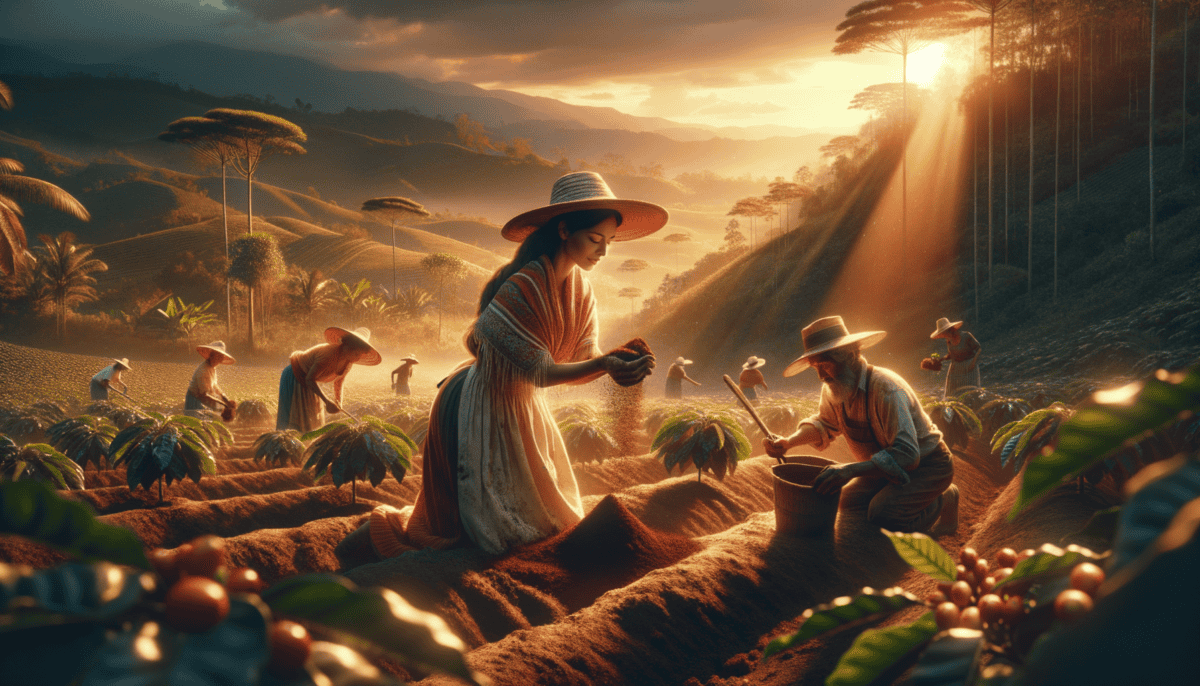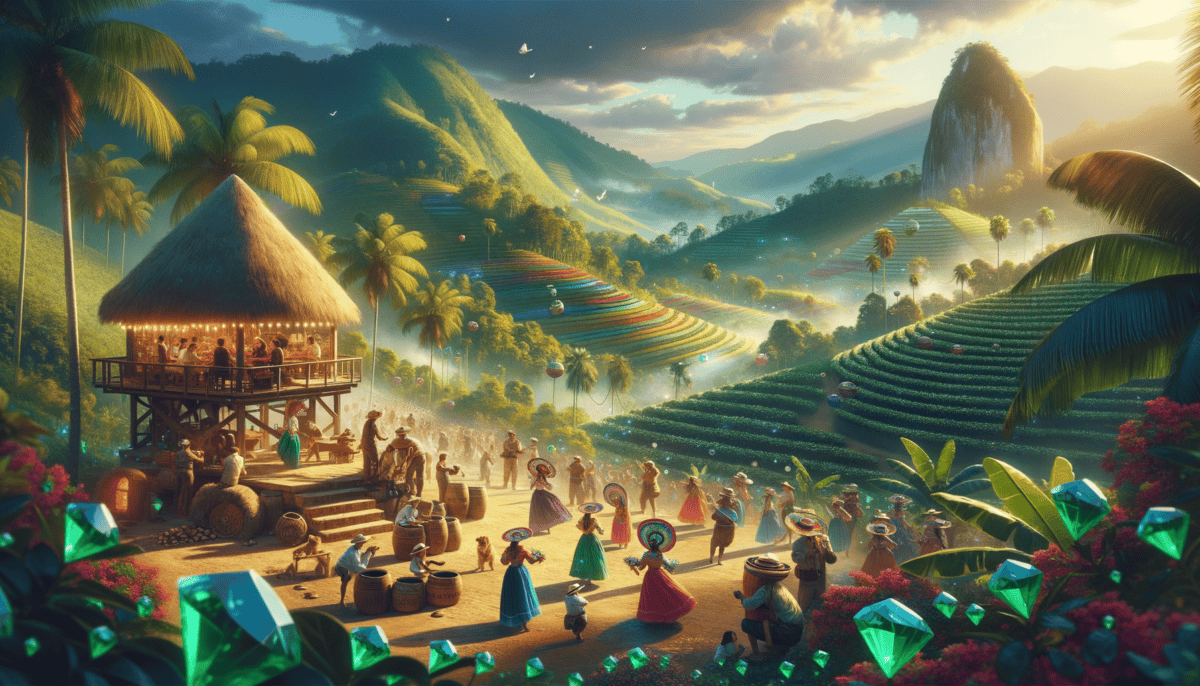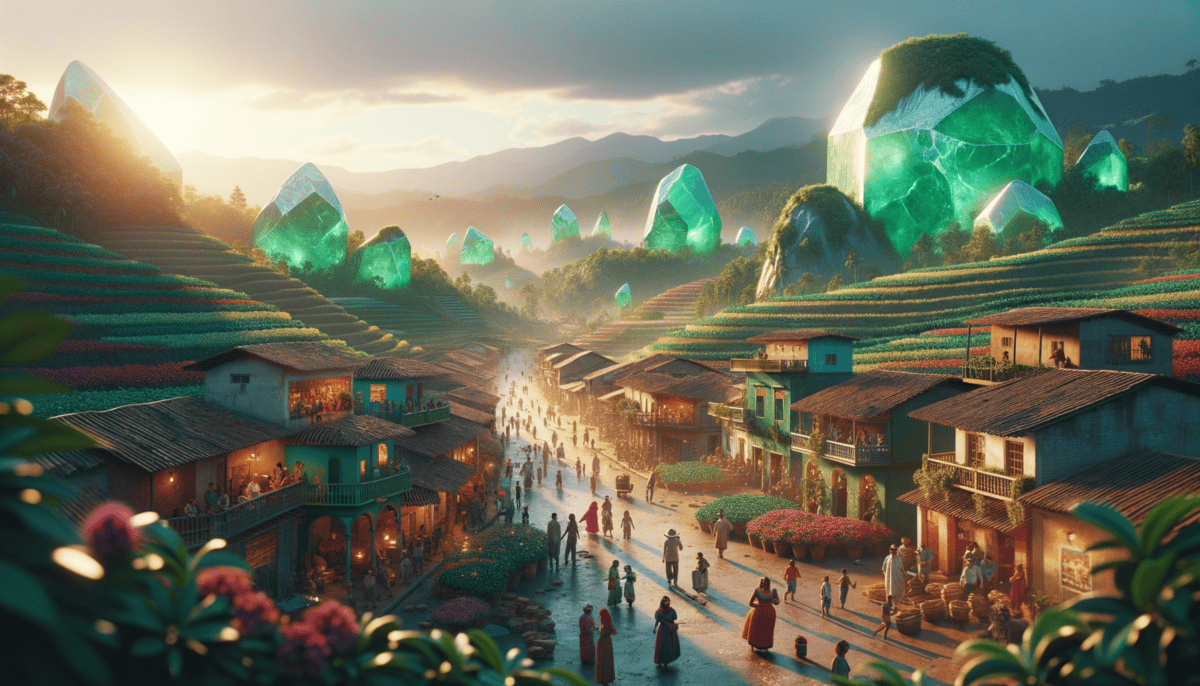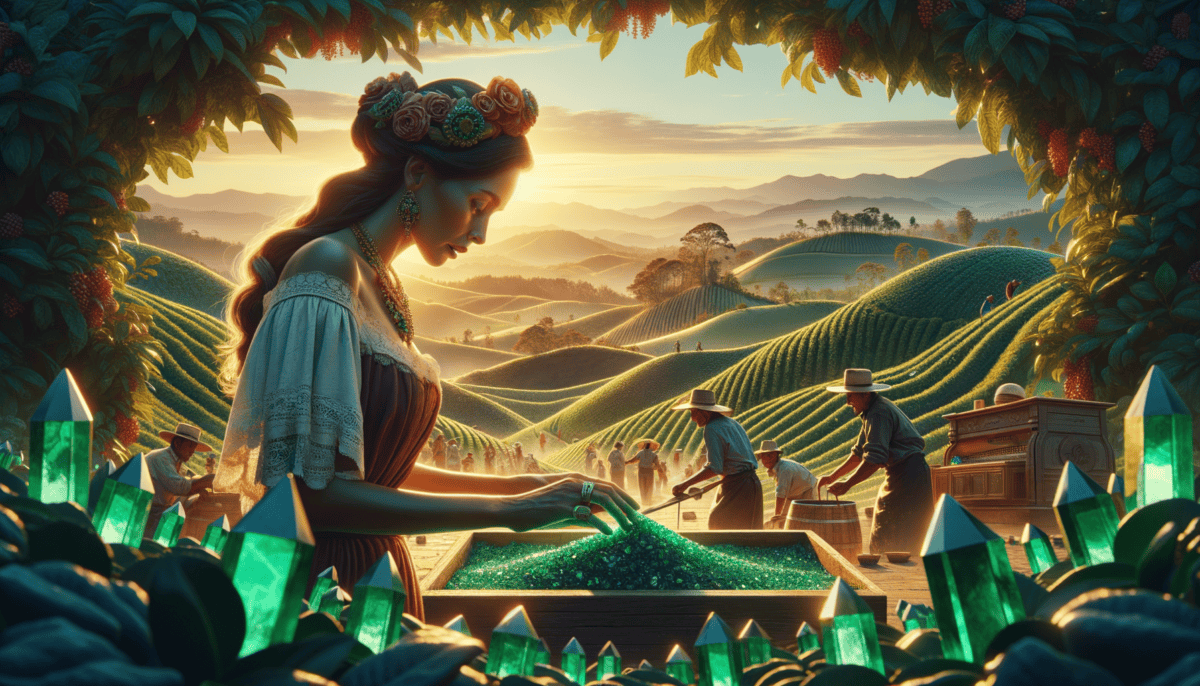The Hidden Treasures of the Mountains
The morning sun peeked over the misty Colombian mountains as Maria watched her father prepare for another day in the emerald mines. At just ten years old, she already knew the sparkle of these precious green stones that had shaped her family's life for generations.
"Papa, tell me again about the first emerald you found," Maria said, helping him pack his small lunch of arepas and coffee.
Her father's weathered face broke into a warm smile. "Ah, mi pequeña, that emerald was as green as the mountains themselves. Your grandfather showed me how to spot them, just as his father showed him."
The Muzo mines, nestled in the heart of Colombia, had been their family's workplace for as long as anyone could remember. These mines weren't just holes in the ground – they were treasure chests holding some of the world's most beautiful emeralds. ✨
“Our emeralds are special, Maria. They shine with a fire that no other country’s stones have,” Papa would often say.
Maria loved watching the miners return each evening, their faces dusty but hopeful. Sometimes they would find emeralds so perfect they seemed to glow from within. Other days brought only rocks and tired muscles. But the miners never gave up.
Living in the mining community meant everyone helped each other. When the Ramirez family found a big emerald, they shared their good fortune. When the Lopez family needed medicine, others pitched in. This was the way of life in their small mountain village.
The most exciting times were when the emerald buyers came from far away. They brought stories of places where Colombian emeralds became beautiful jewelry. Maria imagined her mountains' treasures sparkling in fancy stores in New York and Paris.
"These stones are more than just pretty rocks," her grandmother once told her. "They are pieces of Colombia's heart. Each one carries our story."
Maria learned that their emeralds had been treasured even by ancient peoples. The Muzo Indians, who lived here long ago, believed the stones were the tears of their moon goddess. Now, they helped Colombia share its beauty with the world.
Some days were hard. The mines could be dangerous, and not every family found enough emeralds to live comfortably. But the community stayed strong together, sharing both good times and bad.
One evening, as the sun set behind the mountains, Maria helped sort through her father's findings for the day. Among the rough stones, something caught her eye – a tiny emerald, perfect and pure. Her father let her keep it as her own special treasure.
"Remember, Maria," he said, placing the stone in her palm, "Colombia gives us these gifts, but we must take care of the land that provides them. One day, you'll understand that our true treasure isn't just what we find in the mines – it's in how we look after each other and our beautiful country."
Maria clutched her emerald tightly, feeling connected to all the generations of her family who had worked these mines. She was part of something bigger than herself – she was part of Colombia's story, shining as brightly as the precious stones from their mountains. ️
Seeds of Hope: The Coffee Revolution
As Maria watched her father come home from another difficult day at the emerald mines, she noticed something different. In his hands was not the usual collection of stones, but a small bag of coffee beans.
“Look, mi amor,” he said with excitement in his voice. “Our neighbor Pablo has shown me something wonderful. These coffee plants could be our new treasure.”
The family gathered around their small wooden table as Papa spread out the shiny brown beans. Maria’s grandmother picked one up, smiling at its familiar scent. “When I was young,” she said, “Colombia’s coffee was already famous across the world.”
“But Papa,” Maria asked, “what about the emeralds?”
Her father’s eyes softened. “Sometimes, mi pequeña, we need to plant new dreams. The mines are getting harder to work, but our land – it’s perfect for coffee.”
Over the next few weeks, Maria watched as her father and Pablo worked together to clear a small plot of land. They carefully planted tiny coffee seedlings in neat rows along the mountainside.
“Coffee trees are like children,” Pablo explained. “They need lots of care and patience to grow strong.”
Maria learned that Colombian coffee was special because it grew in the mountains’ perfect climate. The beans needed just the right amount of sun and rain, and the mountain soil made them taste extra good.
Every morning, she helped her father water the young plants. He taught her how to check the soil and remove weeds. “These plants will take time to grow,” he said, “but they will give us coffee cherries year after year.”
Maria’s mother started a small nursery for coffee seedlings. “We can help other families start their own coffee farms,” she said proudly. Soon, their house became a meeting place where neighbors shared farming tips.
One day, Pablo brought exciting news. “There’s a coffee cooperative forming in the valley,” he announced. “They’ll help us sell our coffee beans to big companies!”
The community worked together, just like they had in the mines. But this work felt different – safer and full of hope. They learned about organic farming and how to protect the environment.
Even the children helped. Maria and her friends made games out of counting coffee cherries and checking for ripe ones. The red cherries reminded her of the sparkle of emeralds, but in a new way.
“Look how our mountains are changing,” her grandmother said one evening, gazing at the rows of coffee plants glowing in the sunset. “First they gave us emeralds, and now they give us coffee. Colombia always finds a way to share its gifts.”
As their first coffee plants grew taller, Maria felt proud. She understood now that her family wasn’t just growing coffee – they were growing hope. Their farm would help tell a new story about Colombia, one cup at a time.
Some of the old miners still worked in the emerald mines, but many, like Maria’s father, found new life in coffee farming. The mountains that had given them green gems were now giving them green plants, and the future looked bright with possibility.
At night, Maria dreamed of coffee trees stretching across the hillsides, their branches heavy with ripe red cherries. She knew that something special was growing in their village – not just coffee, but a whole new way of life.
The Cultural Crossroads
The coffee trees were growing tall when Maria first heard the distant sound of drums. The rhythm floated up from the village square, where a festival was starting.
“Mama, what’s that music?” Maria asked, her feet already moving to the beat.
“That’s the sound of our history, mi amor,” her mother smiled. “Let’s go see!”
In the square, dancers twirled in bright clothes. An old man played a wooden flute while children shook maracas. Maria watched in wonder as the dancers moved like colorful butterflies.
“Each dance tells a story,” explained Abuela Rosa, an elder known for her knowledge of traditions. “See how they spin? That’s the story of how our people came together.”
The dancers wore special outfits that made Maria gasp:
- Red skirts that spun like flowers
- Masks painted with animal faces
- Feathers from jungle birds
- Designs from old times
- Shoes with tiny bells
“These dances come from everywhere,” Abuela Rosa said. “From the African people who came long ago, from the native people who lived in our mountains first, and from the Spanish who brought new songs.”
Maria joined a group of children learning simple dance steps. Her feet followed the drum beats while her hands waved like birds. She felt like she was part of something bigger than herself.
As the sun set, more villagers shared stories. Maria learned about the Wayuu people who weave beautiful bags, the Emberá who paint their skin with natural dyes, and the wisdom of healing plants passed down through generations.
“But how do we keep these traditions alive?” someone asked. Maria noticed worry in some of the older people’s faces.
“By teaching our children,” Carmen answered firmly. “By dancing, singing, and telling our stories. Just like we’re doing today!”
Maria helped serve traditional foods at the festival. Each dish had its own story:
“We are like this festival,” her father said, watching the celebration. “Many different parts coming together to make something beautiful.”
That night, Maria dreamed of dancing coffee trees and singing emeralds. She understood now that Colombia’s real treasure wasn’t just in its gems or crops – it was in its people and their stories.
The next morning, Maria asked Carmen to teach her more dances. Other children joined them, and soon they were practicing every evening after working in the coffee fields.
“See?” Carmen smiled as the children danced. “Our traditions are alive and growing, just like our coffee plants.”
Maria realized she was part of a special place where old and new things grew together – where coffee farmers danced ancient steps, and where children like her could help keep their culture strong.
As she walked home through the coffee trees, Maria hummed one of the festival songs. The breeze carried the scent of coffee blossoms, and far away, she could still hear the drums beating like the heart of Colombia.
Resilience in the Face of Adversity
Dark clouds gathered over the coffee fields as Maria helped her father check the plants. The coffee prices had dropped again, and worry lines creased Papa’s forehead. ️
“Will we be okay, Papa?” Maria asked, touching a coffee berry.
“We are Colombians, mi pequeña,” he smiled. “We know how to be strong.” But his eyes held concern.
That evening, neighbors gathered in the village square. Maria listened as they shared their worries:
- ☔ Rain had been scarce
- Coffee prices were low
- Bills were getting harder to pay
- Some families couldn’t afford school supplies
- Seeds were becoming expensive
“What if we work together?” suggested Carmen, standing up. “My grandmother always said ‘Una mano lava la otra’ – one hand washes the other.”
“Yes!” agreed Pablo. “I can teach others how I save water on my farm. Maria’s father knows about organic growing. We all have something to share!”
The community began to change. Neighbors helped each other more than ever:
Maria watched as the village created new ways to help everyone:
Carmen started a small shop where local crafters could sell their work. Maria’s mother began teaching other women how to make special coffee drinks to sell in the city.
“See how strong we are together?” Papa said one evening, counting better earnings from their improved coffee sales. “Like the coffee plants that grow best in groups.”
The children played their part too. Maria and her friends started a vegetable garden at school. They learned about growing food and shared the harvest with families who needed help.
“You kids are so clever!” beamed the teacher. “You’re showing us that even small hands can make big changes.”
As months passed, things slowly got better. The community had learned new ways to help each other. Even when problems came, they faced them together.
One day, visitors from the city came to see how the village had improved things. They were impressed by how everyone worked together.
“Your community is showing others how to be strong,” said one visitor. “You’re teaching Colombia about the power of working together!”
That night, at dinner, Maria’s family talked about how things had changed. The worry lines on Papa’s face had softened. Mama smiled more often.
“We didn’t just survive the hard times,” Mama said, serving fresh bread from Carmen’s shop. “We learned to be better, together.” ❤️
Maria looked out at the coffee fields, now thriving with new growing methods. The school garden was full of vegetables. The craft shop buzzed with activity.
She understood now that being strong didn’t mean facing problems alone. It meant joining hands with others and finding new ways forward, just like Colombians had always done.
Global Connections
The morning sun sparkled through Maria’s window as she packed her small bag. Today was special – she would join her father on his first international coffee sale trip! ✈️
“Ready for your big adventure, mi amor?” Mama asked, fixing Maria’s collar.
“I can’t wait to show everyone our special Colombian coffee!” Maria bounced with excitement.
At the airport, Maria saw people from many countries. Some wore business suits, others colorful traditional clothes. She heard different languages mixing in the air like music.
“Papa, look! That lady is wearing an emerald necklace like the ones from our old village!”
Papa smiled. “Yes, mijita. Colombian emeralds are famous worldwide. Just like our coffee!”
During their presentation to international buyers, Maria helped her father tell their story:
The buyers loved their coffee! One woman from Japan said, “This isn’t just coffee – it’s a piece of Colombia’s heart.”
Maria proudly showed pictures of their village:
- Beautiful mountain landscapes
- Local art and crafts
- Traditional dance festivals
- Community working together
- ☕ Sustainable coffee farming
“Your country is amazing!” said a buyer from Canada. “We want to share your story with our customers.”
That evening, Maria video-called her friends back home. “Guess what? Our coffee will be in stores in five different countries!”
The next day, they visited a big international cultural fair. Maria saw Colombian dancers performing, and craft sellers displaying emerald jewelry.
A reporter interviewed Maria about being a young Colombian coffee farmer’s daughter. She spoke proudly about her community:
“We work hard and help each other. Our coffee is special because it’s made with love and care for the earth.”
Before flying home, Maria bought small gifts for everyone in the village. She found a magazine that featured Colombian art and innovation.
“Papa,” she said, “I’m so proud to be Colombian. We give so many beautiful things to the world!”
Back home, Maria’s stories inspired her friends. They started learning English to talk with international visitors. Some dreamed of selling their crafts globally.
The village began hosting tourists who wanted to learn about coffee farming. Maria helped translate and shared stories about Colombian culture.
One evening, watching the sunset over the coffee fields, Maria thought about how far they’d come. Their village wasn’t just growing coffee anymore – it was growing connections across the world.
“We’re like a bridge,” she told her little brother. “A bridge between Colombia and the whole world!”
A New Generation’s Promise
Maria stood on the hilltop overlooking her village, watching the sunset paint the coffee fields golden. Five years had passed since her first international trip. So much had changed!
“Remember when we only dreamed of sharing our coffee with the world?” Maria’s father wrapped an arm around her shoulders.
Now eighteen, Maria led tours through their sustainable coffee farm. Today’s group included students from a local university and visitors from abroad.
“Here’s where our story begins,” Maria explained, holding up a coffee bean. “Each bean carries our history, our culture, and our dreams.” ☕
“What makes Colombian coffee so special?” asked a young visitor.
Maria smiled, sharing the wisdom passed down through generations:
- Ancient farming techniques
- Perfect mountain climate
- Care for the environment
- ❤️ Community support
- Sharing knowledge
In the village center, local artisans now displayed their crafts alongside coffee products. Maria’s mother taught traditional weaving to younger girls.
The old emerald mine where her grandfather once worked had become an educational center. Children learned about geology while elders shared stories of Colombia’s mineral heritage.
Maria’s little brother, now twelve, taught traditional dance to visitors while explaining its history. “Every step tells a story about Colombia!” he’d say proudly.
That evening, the village gathered for their monthly celebration. The aroma of fresh coffee mixed with traditional cooking filled the air.
“Look what arrived today!” Maria’s father announced, holding up a magazine. Their village was featured in an international article about sustainable farming and cultural preservation.
As music played and children danced, Maria watched her community with joy. Young and old worked together, keeping traditions alive while embracing new ideas.
The next morning, Maria met with a group of young entrepreneurs from nearby villages. They were starting a cooperative to support small farmers and artisans.
“When we work together,” Maria told them, “we’re stronger. Just like our ancestors knew.”
Later, Maria wrote in her diary about her hopes for Colombia’s future. She dreamed of more young people finding ways to celebrate their heritage while creating new opportunities.
“We are like the coffee plants,” she wrote. “Our roots go deep into rich soil of tradition, but we keep growing toward the sun, reaching for new possibilities.”
As night fell over the mountains, Maria looked at the stars twinkling above their village. She thought about all the ways Colombia had enriched the world – through emeralds, coffee, culture, and most importantly, through its people’s spirit.
Tomorrow would bring new challenges and opportunities. But Maria knew that as long as they remembered their past while embracing their future, Colombia’s gifts to the world would only grow stronger.
Under the starlit sky, the village’s lights twinkled like emeralds, each one representing a dream, a story, and a promise for tomorrow. ✨






